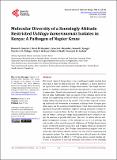| dc.contributor.author | Omayio, Dennis O. | |
| dc.contributor.author | Musyimi, David M | |
| dc.contributor.author | Muyekho, Francis N. | |
| dc.contributor.author | Ajanga, Samuel I. | |
| dc.contributor.author | Midega, Charles A. O. | |
| dc.contributor.author | Wekesa, Clabe S. | |
| dc.contributor.author | Okoth, Patrick | |
| dc.contributor.author | Kariuki, Innocent W. | |
| dc.date.accessioned | 2018-05-18T09:13:16Z | |
| dc.date.available | 2018-05-18T09:13:16Z | |
| dc.date.issued | 2018-04-27 | |
| dc.identifier.citation | Omayio, D.O., Musyimi, D.M., Muyekho, F.N., Ajanga, S.I., Midega, C.A.O., Wekesa, C.S., Okoth, P. and Kariuki, I.W. (2018) Molecular Diversity of a Seemingly Altitude Restricted Ustilago kamerunensis Isolates in Kenya: A Pathogen of Napier Grass. American Journal of Molecular Biology, 8, 119-143. https://doi.org/10.4236/ajmb.2018.82011 | en_US |
| dc.identifier.issn | 2161-6663 | |
| dc.identifier.issn | 2161-6620 | |
| dc.identifier.uri | https://repository.maseno.ac.ke/handle/123456789/513 | |
| dc.description.abstract | The Central region of Kenya which is the second largest market oriented dairy
zone, faces a threat in milk production. The challenge is a disease known as
the napier head smut caused by Ustilago kamerunensis. This fungal microorganism
is a facultative pathogen which has been reported to cause yield losses
in napier grass (Pennisetum purpureum) ranging from 25% to 46% across the
affected areas. Additionally, there are reports of the continual spread of the
disease into neighbouring county of Nakuru in Rift-Valley region which is the
leading milk producing zone in the country. This scenario of spread is worrying
combined with observation of variations in damage levels of napier grass
clones across the five counties of Central Kenya. These observations led to the
hypothesis that possible differences might be existing among the Ustilago kamerunensis
variants in Kenya. Further, the differences in biomass yield losses
that are within a certain percentage range mentioned-above, seemed to support
the existence of possible differences. Therefore, to inform effective integrated
management strategies of the pathogen in case it’s co-evolving, this
study sought to determine the molecular differences of Ustilago kamerunensis
isolates in affected counties using ITS 1 and 2 regions which are spanned by
5.8S ribosomal RNA gene. The Ustilago kamerunensis propagules were systematically
collected from affected counties’ hot spot areas for sequencing and
phylogenetic analysis. The study revealed the most affected areas to be within
the mean altitude level of 1988.17 ± 71.97 metres above sea level. Further, differences
in the growth in vitro and molecular characteristics of the seemingly altitude restricted isolates were observed. The Kiambu, Nyandarau and Nakuru
counties isolates clustered together, whereas those of Murang’a, Nyeri
and Kirinyaga formed another clade. The sequences of sixteen Ustilago kamerunensis
isolates were deposited in GenBank with accession numbers
ranging from MG722754 to MG722769. The results suggest the existence of
possible genetic divergence of the isolates which might be reflected in their
pathogenic potential too. Effective integration of management strategies is vital
towards slowing the phenomenon for an optimal mitigation of the disease
in Kenya. | en_US |
| dc.publisher | American Journal of Molecular Biology | en_US |
| dc.subject | Ustilago kamerunensis, Diversity, Altitude, Napier Grass, Milk | en_US |
| dc.title | Molecular Diversity of a Seemingly Altitude Restricted Ustilago kamerunensis Isolates in Kenya: A Pathogen of Napier Grass | en_US |
| dc.type | Article | en_US |

